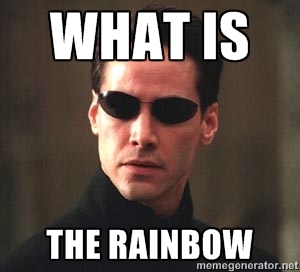It may seem a bit weird that in part 3 of a series, we’re talking about what something is.

After all, shouldn’t that be part 1? Nope, this is iterative development :)
So, what is Rainbow? Rainbow is designed to be a complete replacement for the Sitecore serialization format and filesystem organization, as well as enabling cross-source item comparison. It is a pure code library that comes with no UI of any kind, that is designed to be used with other libraries that use its serialization services with their own UIs. Libraries that consume Rainbow - such as Unicorn - gain the ability to abstract themselves from serialization details. Libraries that extend Rainbow can add new serialization formats, new places to store serialized items, and new ways to organize them.

Rainbow Features
Universal Item Data and Data Stores
Rainbow implements a set of interfaces that wrap the structure of a Sitecore item - item, version, and field. These interfaces provide a universal language that all Rainbow data stores can implement against. You could get an IItemData from Sitecore and write it out to disk as a YAML formatted item. You could get an IItemData from a web service, and deserialize it into a Sitecore database. You could construct an IItemData programmatically, and serialize it to a Sitecore database. Implementations of IDataStore provide places to store item data. It’s completely universal, and everything Rainbow does revolves around these abstractions.
YAML-based serialization formatter improves the storage format for serialized items
- This post goes into more detail about the hows and whys of the YAML serializer
- The format is valid YAML. YAML is a language that is designed to store object graphs in a human readable fashion. It uses significant whitespace and indentation to denote data boundaries. Note: only a subset of the YAML spec is allowed for performance reasons.
- Any type of endline support. Yes, even
\rbecause one of the default Sitecore database items uses that in its text! No more.gitattributesneeded. - No more
Content-Lengthon fields that requires manual recalculation after merge conflicts - Multilists are stored multi-line so fewer conflicts can occur
- XML fields (layout, rules) are stored pretty-printed so that fewer conflicts can occur
- Customize how fields are stored when serialized yourself with Field Formatters
Serialization File System (SFS) storage hierarchy
- This post goes into more detail about SFS
- Human readable file hierarchy
- Extremely long item name support
- Unlimited path length support
- Supports non-unique paths (two items under the same parent with the same name), while keeping it human-readable
- Stores each included subtree in its own hierarchy, reducing file name length
- You can plug in the serialization formatter you desire - such as the YAML provider - to format items how you want in the tree
Deserialize abstract items into Sitecore with the Sitecore storage provider
- Turn Sitecore items into
IItemDatawith theItemDataclass - Deserialize an
IItemDatainstance into a Sitecore item withDefaultDeserializer(used viaSitecoreDataStore) - Query the Sitecore tree in abstract with
SitecoreDataStore, as if it were any other serialization store
Item comparison APIs
- Compare any two
IItemDatainstances regardless of source - Customize comparison for field types or specific fields with Field Comparers
- Get a complete readout of changes as an object model
Improvements
Improvements are in comparison to Sitecore serialization and the functionality in Unicorn 2.
- Deleting template fields will no longer cause errors on deserialization for items that are serialized with a value for the deleted field (e.g. standard values)
- Deserialization knows how to properly change field sharing or field versioning and port existing data to the new sharing setting
Rainbow Organization
Rainbow consists of several projects:
- The core
Rainbowproject contains core interfaces and components that most all serialization components might need, for example SFS, item comparison tools, field formatters, and item filtering Rainbow.Storage.Yamlimplements serializing and deserializing items using a YAML-based format. This format is ridiculously easier to read and merge than standard Sitecore serialization format, lacking any content length attributes, supporting any type of newline characters, and supporting pretty-printing field values (e.g. multilists, layout) for simpler merging when conflicts occur.Rainbow.Storage.Scimplements a data store using the Sitecore database. This can be used to read and write items to Sitecore using theIDataStoreinterface.
Extending Rainbow
Rainbow is designed to be loosely coupled. It’s recommended that you employ a Dependency Injection framework (e.g. SimpleInjector) to make your life constructing Rainbow objects easier. Of course you can also construct objects without DI.
Rainbow has extensive unit and integration tests and hopefully easy to understand code, which serve as its living documentation. As of now, Rainbow has 90% test coverage and 220 tests. Unicorn, which uses Rainbow as a service, can also be a useful source of examples.
If you can’t find what you’re looking for you can find me on Twitter (@kamsar) or on Sitecore Community Slack.
Next time, we’ll start talking about what’s new in Unicorn 3 - other than all the Rainbow things that come along because Unicorn uses Rainbow.